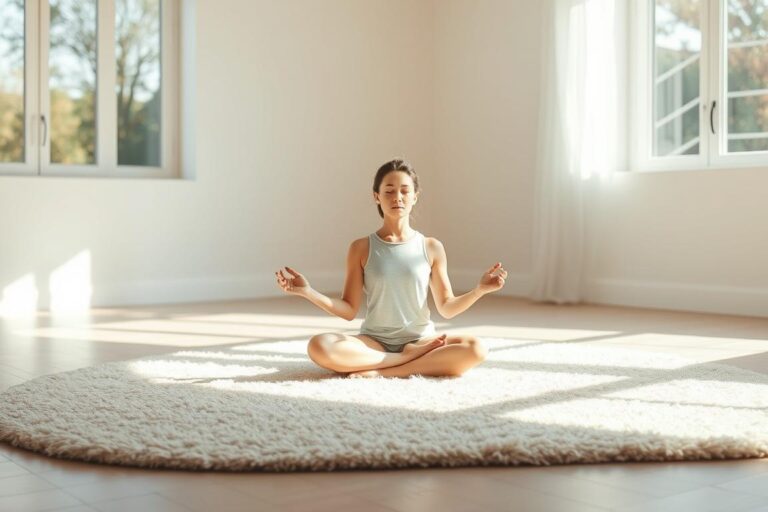A comparison of types of meditation: from mindfulness to mantra
In a world that is becoming increasingly hectic, more and more people are looking for ways to find inner peace and serenity. Meditation offers a valuable retreat for your mind, where you can organize your thoughts and reduce stress.
There are many different forms of meditation, which differ in their origin, practice and objectives. From silent mindfulness meditation to dynamic movement meditation, there is a suitable technique for every character and every need.
This comparison of the 10 most important types of meditation is designed to help you find clarity and discover your personal meditation path. Each form of meditation has its own unique approach and effect that can help you bring more awareness into your life.
Important findings
- Discover the variety of types of meditation and find the right one for you.
- Learn how meditation reduces stress and promotes inner peace.
- Understand the different approaches and effects of the various forms of meditation.
- Find out how meditation can improve your awareness and mental clarity.
- Get inspiration to start your own meditation path.
The world of meditation: an overview
Meditation is an ancient practice that has taken on new meaning in our modern world. It offers a multitude of benefits for body and mind.
What is meditation and where does it come from?
Meditation originally comes from spiritual traditions, particularly Buddhism and Hinduism. It was developed to help people control their thoughts and achieve inner peace.
Today, meditation is practiced worldwide, regardless of cultural or religious background, to improve general well-being.
Why meditation is important for your well-being
Meditation helps you to reduce stress and better regulate your emotions. Through regular meditation, you can improve your ability to concentrate and arrive in the here and now.
The positive effect of meditation on your health has been scientifically proven: It can relieve chronic pain, lower blood pressure and improve sleep quality.
- Meditation is a powerful antidote to stress and excessive demands.
- Regular meditation offers health benefits for chronic pain and high blood pressure.
- Meditation helps to better regulate emotions and improves the ability to concentrate.
A comparison of types of meditation: the basics
Not all meditation is the same – there are numerous approaches you can try out to find the right one for you. The variety of meditation types can be overwhelming at first, but with an open mind and a willingness to try new things, you can discover the right method for you.
Moving vs. non-moving meditation
One of the basic distinctions between types of meditation is between moving and non-moving meditation. Moving meditations such as yoga or walking meditation combine physical movement with mental concentration. They are ideal for people who have difficulty sitting still or who like to be active. On the other hand, non-moving meditations, such as sitting meditation, offer a way to calm the mind and find inner peace.
As a beginner, you can start with guided meditations to help you get into the practice and calm your mind.
How to find the right type of meditation for you
Choosing the right type of meditation is a personal process. Consider your lifestyle and personality when making your choice. If you are an active person, a moving meditation such as yoga or walking meditation might suit you better. If you love stillness, try a seated meditation. Take time to experiment with different types of meditation and pay attention to the reactions of your body and mind.
- Take time to try out different types of meditation.
- Pay attention to your physical and mental reactions.
- Choose a type of meditation that suits your lifestyle.
Buddhist meditation techniques: Zazen and Vipassana
Buddhist meditation techniques offer a variety of methods to achieve inner peace and clarity. Two of the best known and most influential techniques are zazen and vipassana, which are rooted in the Buddhist tradition.
Zazen – Meditation in Zen Buddhism
Zazen, also known as „sitting meditation“, is a central practice in Zen Buddhism. It involves sitting upright and quietly, concentrating on your breathing and letting go of your thoughts without judging them. This form of meditation helps you to train your mindfulness and achieve a state of deep inner calm. Through regular practice, you can improve your ability to be present in the moment and control your reactions to external stimuli.
Vipassana – The path to insight
Vipassana is another important form of meditation in Buddhism that aims to promote insight and wisdom. The term „vipassana“ means „insight“ or „clear-sightedness“ and refers to the ability to see things as they really are. In Vipassana meditation, you first focus your attention on your breathing and then expand your awareness to body sensations, thoughts and emotions, which you observe with equanimity. This practice helps you to recognize unconscious patterns and free yourself from obstructive habits, which can lead to profound transformation.
By practicing Vipassana, you can increase your mindfulness and learn to better understand your thoughts and emotions. It is a form of meditation that encourages you to arrive in the moment and accept your experiences without judgment.
Loving meditation: Metta and chakra
Discover the transformative power of loving-kindness meditation through metta and chakra. These two meditation techniques can help you find your inner balance and boost your energy.
Metta – The meditation of loving kindness
Metta meditation, also known as loving kindness meditation, enhances your ability to show love and compassion to yourself and others. Through regular practice, you can improve your relationships and develop a sense of inner peace. This technique helps you to go through everyday life with mindfulness and love.
Chakra meditation – focus on energy centers
Chakra meditation focuses on the seven main energy centers in your body. By visualizing and opening these chakras, you can release blockages and restore energy balance. This practice can lead to more balance, relaxation and an increased awareness of the subtle energies in your body.
Regular chakra meditation can help you to strengthen your physical, emotional and spiritual health. By focusing on each chakra, you can activate and harmonize your energy centers, which can lead to a sense of clarity and inner harmony.
Dynamic forms of meditation: Osho and walking meditation
Dynamic forms of meditation offer a variety of approaches to cultivating mindfulness and inner peace. They allow you to experience meditation not only in silence, but also in motion.
Osho – The dynamic meditation
Osho meditation is a dynamic form of meditation that connects body, mind and soul. Through a combination of movement, breathing and stillness, you can turn your attention inwards and achieve a deeper awareness. This type of meditation helps you to release inner tension and channel your energy.
Walking meditation – Mindful in motion
Walking meditation is another dynamic form of meditation in which you focus your mindfulness on each step. By focusing on lifting your foot, moving forward and putting it down, you bring your attention into the present moment. This practice helps you to sharpen your senses and become more aware of your surroundings, which leads to greater inner peace and relaxation.
Regular walking meditation can also improve your ability to walk mindfully through everyday life, even during everyday activities.
Meditation with sound: mantra and transcendental meditation
Sound meditations, such as mantra meditation and transcendental meditation, offer a unique way to reduce stress and find inner peace. By using sound in meditation, you can improve your concentration and achieve a state of deep relaxation.
Mantra meditation – the power of repetition
Mantra meditation is a simple but effective technique in which a specific word or phrase is repeated to calm the mind. By repeating the mantra, you can organize your thoughts and achieve a state of calm and relaxation. This method helps you to reduce stress and improve your inner balance.

Transcendental meditation – the path to inner peace
Transcendental Meditation is a special form of mantra meditation that was developed by Maharishi Mahesh Yogi in the 1950s. In this technique, you practise twice a day for 20 minutes each time, using a personal mantra assigned to you by a certified TM teacher. The aim of Transcendental Meditation is to reduce stress and negative emotions and achieve a state of inner peace and relaxation.
Modern approaches to meditation: Mindfulness and Kundalini
Modern approaches to meditation such as mindfulness and Kundalini yoga offer a variety of techniques to expand your awareness and strengthen your inner energy. These practices help you to deepen your meditation experience and enrich your spiritual journey.
Mindfulness meditation – In the here and now
Mindfulness meditation focuses on being in the present moment. By cultivating mindfulness, you can expand your awareness and improve your ability to deal with stress and challenges.
This practice helps you to better understand and regulate your thoughts and emotions, leading to deeper inner peace and clarity.
Kundalini Yoga – Awaken your inner energy
Kundalini Yoga is a powerful combination of dynamic movements, breathing techniques, mantras and meditation that aims to awaken and channel the Kundalini energy upwards. This practice combines physical exercises with spiritual depth and can activate your energy, clear your mind and expand your consciousness.
The breathing techniques in Kundalini Yoga, especially the ‚breath of fire‘, help you to activate energy and strengthen your inner balance. Through regular practice, you can improve your physical and mental health and deepen your spiritual journey.
Meditation in everyday life: practical tips for beginners
To integrate meditation into your everyday life, you should start with small, achievable steps. Many people who start meditating have unrealistic expectations of the results. Meditation is not a magic pill, but a practice that requires time, patience and regularity to unfold its profound effect.
How to incorporate meditation into your daily routine
Start with short, guided meditations of around 5 minutes a day. This will help you to establish a regular meditation practice. Choose a type of meditation that suits you and adapt it to your lifestyle. It is important that you see meditation as part of your daily routine, similar to brushing your teeth or eating breakfast.
Common mistakes and how to avoid them
A common mistake for beginners is to expect immediate results. Meditation requires time and patience. Another mistake is to be too hard on yourself. It is important that you do not judge your meditation experience and do not get discouraged if your mind wanders during meditation. Instead, you should learn to observe your thoughts and gently guide them back to meditation.
By following these tips and meditating regularly, you can structure your thoughts, find inner peace and improve your overall balance.
Conclusion: Your path to the right meditation practice
Discover the diversity of meditation and find your own personal practice. Meditation is a journey that has accompanied people all over the world for thousands of years. Through the different types of meditation, you can positively influence your mind and body and achieve greater peace and well-being.
As a beginner, you can start with short meditations of 5-10 minutes. The important thing is that you meditate regularly and have patience. Whether you choose transcendental meditation, yoga or mindfulness meditation, each practice can help you to bring more relaxation and clarity into your life.
The world of meditation is diverse and there are many ways to find inner peace. Find out what helps you the most and make it part of your everyday life.






